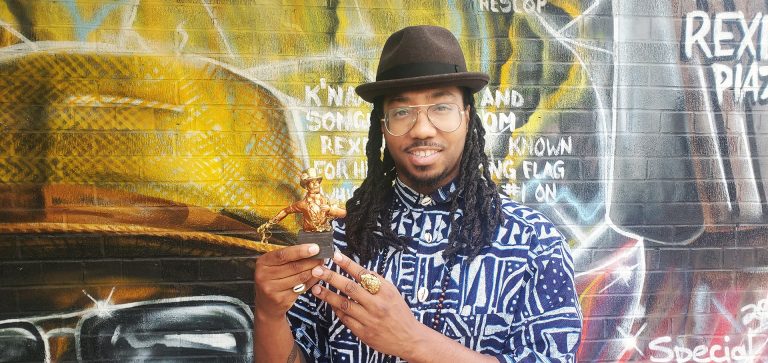Concordia student to create a memorial sculpture of abolitionist Joshua Glover in Toronto

Concordia graduate student Quentin VerCetty has won a City of Toronto public art competition to create a sculpture commemorating abolitionist and former slave Joshua Glover.
VerCetty is currently pursuing his master’s degree in art education.
Glover fled slavery in the United States in 1854 and arrived in what is now Toronto’s Etobicoke municipality, where he helped lead the abolitionist movement. The Etobicoke Historical Society spearheaded the mission to honour Glover.
VerCetty is also from Etobicoke, and says he ended up seeing a definite connection between Glover’s story and his own. “I came from a place where I felt like the choices I could make and the opportunities that I had were limited by my circumstances,” he says.
Much of VerCetty’s work is based on the concept of Afrofuturism, which he describes as “any futuristic or imaginative creation — oftentimes in science fiction, fantasy or horror — that is inspired by African history, tradition or cultures.”
VerCetty’s Afrofuturistic approach helped him develop the winning sculpture design and provided a lens through which he could relate to Glover.
“We both had to be able to imagine more for ourselves than what we could see,” VerCetty says. “For Joshua Glover, that moment was when he realized he was not a slave but, rather, that he was enslaved, and that he deserved to be treated like any other human being.”
Education in common
Both VerCetty and Glover came to appreciate the value of education.
“I recognized that there was life outside of being racially profiled, or being told all I could do was be a drug dealer or a basketball player,” VerCetty says.
“Once I started to imagine myself outside of the limitations of my circumstances, that’s when I started to find my way towards freedom — which was education.”
Glover also found his path to freedom through education. He taught himself to read and write, which eventually led to his ability to forge his own freedom papers, cross borders and — with the help of abolitionists — eventually end up in Canada.
“That’s the second connection between me and Joshua Glover,” says VerCetty. “People who believed in seeing us achieve our highest potential. For him, it was the abolitionists. For me, it was the numerous teachers and mentors who I have had along the way, who saw that I deserved more.”
These mentors helped VerCetty earn many academic honours, including the Governor General’s Bronze Medal Award in 2010 and a scholarship that led him to Concordia.
“Formerly a high school dropout, I realized that I was suddenly in the position to graduate from high school and go on to university,” says VerCetty. “It was in large part thanks to the support of individuals who believed in the abolition, per se, of limitation.”
Despite the support VerCetty has, he says he still faces forms of academic racism — often stemming from a lack of Black representation within faculties as well as a lack of Black history in the curriculum.
“By including these buried histories in our schooling, it allows us to bring in new reference points that can deepen our understanding of how to help human beings become better human beings,” says VerCetty.
“By unearthing these things, we’re helping these stories become more accessible, and that helps us become better educators, better artists, and pushes academia further than where it currently is.”
He says including Black stories and Afro-Indigenous stories in the public space — such as Glover’s monument — encourages accessible education and using art as a teaching tool.
Mother’s influence
“I’ve known about Glover since I was a child because my mom taught me about him,” says VerCetty.
“Despite not being an ‘educated’ woman according to Western standards, my mom really emphasized education. She doesn’t have a high school diploma, but she reads a lot, and she told me about this Black man who lived in the Etobicoke neighbourhood a long time ago,” he says.
VerCetty’s mother also taught him computer programming, which eventually led to the 3D design work he does now.
“It’s kind of cool how one can plant a seed, and that seed can grow and bear fruits,” says VerCetty.
“I just hope that the work that I’ve done continues — that it is also a seed that will bear fruits in many hearts and many minds. I hope that people continue to deepen their learning about the histories they may not see; to ask questions and investigate on their own. That’s really how we can create the change that we want to see.”
VerCetty is also exploring augmented-reality technology and taking part in fellowships with Monument Lab and the Goethe-Institut, where he is collaborating with others on a transnational exhibition on monuments, public memory, public space and accessibility.
“The project is currently evolving because of the social climate, which is great,” says VerCetty. “It only enriches the work that we’re creating.”
Learn more about Concordia’s Department of Art Education.


